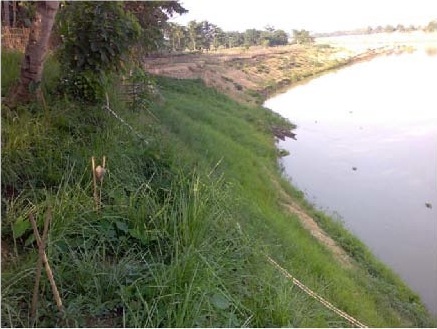 |
Unprotected natural or constructed earthen slopes are a major point source erosion problem that can result in serious sediment flows to lower catchment sites, contamination of rivers and streams, water quality reduction, slope failure and slippage that often result in landslides, economic damage to property, and loss of life. The Vetiver System can effectively and at low cost, protect slopes, stop or significantly reduce the risk of slippage (shallow slopes), and prevent down stream water contamination. This is because vetiver grass roots have a high tensile strength - average 75 MPa that can increase shear strength of soil by a factor of 40, and when planted on slopes vetiver will reduce slope hydraulic pressures through the removal (transpiration) of water. The combination of slippage prevention (mass wastage of soil) and its sediment filtering ability results in very clean water moving down the catchment.
The handbook: The Vetiver System for Slope Stabilization describes in detail VS applications. It has been written primarily for engineers and contains case studies and many color images of VS applications. The book can be downloaded or can be purchased as hard copy from Amazon.com>
TVNI's archives contains many papers and references to VS for slope stabilization.
|
Photo essays of Slope Stabilization:
VETIVER SYSTEM TECHNOLOGY FOR INFRASTRUCTURE STABILIZATION. There are many companies in the tropics using VS for infrastructure protection . Here is presentation by Paul Truong (TVNI'sTechnical Director).
 Biotechnology Environmental Solutions (Soluciones ambientales en biotecnología)using the Vetiver System. Yorleny Cruz , a TVNI Director and Coordinator for Costa Rica and Central America as well as a senior partner of Vetiver Panama SA, has shared with us an excellent presentation in Spanish (with some English). The presentation focuses on wet tropical bioengineering stabilization of roads, river and canal banks, gullies, drainage. and landslide works using the Vetiver System. It comprises some 127 slides and should be very useful for introducing VS technology to new clients particularly those needing solutions to deal with the extreme rainfall events that are occurring more frequently because of climate change. Biotechnology Environmental Solutions (Soluciones ambientales en biotecnología)using the Vetiver System. Yorleny Cruz , a TVNI Director and Coordinator for Costa Rica and Central America as well as a senior partner of Vetiver Panama SA, has shared with us an excellent presentation in Spanish (with some English). The presentation focuses on wet tropical bioengineering stabilization of roads, river and canal banks, gullies, drainage. and landslide works using the Vetiver System. It comprises some 127 slides and should be very useful for introducing VS technology to new clients particularly those needing solutions to deal with the extreme rainfall events that are occurring more frequently because of climate change.
 Stabilization of a 2000 km highway in Vietnam - The vital role of the Vetiver System. Recently Paul Truong revisited sections of the Ho Chi Minh Highway, Vietnam, that have been stabilized with Vetiver System applications. He prepared this photo essay that shows the impact of VS over a fouteen year period. (2000 - 2014). We are indebted to Van Tran and Tran Man (former and current Vetiver Network coordinators in Vietnam for some of the photos and the incredible work that was performed on this highway that follows the alignment of Vietnam's famous Ho Chi Minh Trail. Stabilization of a 2000 km highway in Vietnam - The vital role of the Vetiver System. Recently Paul Truong revisited sections of the Ho Chi Minh Highway, Vietnam, that have been stabilized with Vetiver System applications. He prepared this photo essay that shows the impact of VS over a fouteen year period. (2000 - 2014). We are indebted to Van Tran and Tran Man (former and current Vetiver Network coordinators in Vietnam for some of the photos and the incredible work that was performed on this highway that follows the alignment of Vietnam's famous Ho Chi Minh Trail.
The work and impact of these VS applications have to be considered, with the test of time, successful. There were some land slips (1 meter and 10 meter deep) that VS could not prevent, even so the overall results were excellent. Contrary to views of some critics the Vetiver System: (a) protected slopes of over 60%, (b) protected slopes against very high rainfall, (2000 mm per year) including extreme events under typhoon conditions, (c) provided a microclimate that allowed native plant species to naturally establish and eventually shade out the vetiver to the extent that in 2014 there is little evidence of vetiver in the earlier plantings - NOTE where native species did not establish vetiver continued to grow and protect the slopes, (d) resulted in a much reduced investment cost (estimated at 90% of hard engineering solutions), and minimum annual maintenance costs, and (e) proper engineering designs would assure even better results of VS application as a stand alone technology or in combination with hard engineering technology.
The experience on this highway confirms that VS could be applied widely for slope stabilization in developing countries where climate permits and where labor is relatively cheap. It also confirms the need for good engineering design.
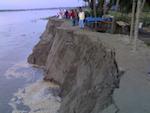 Controlling Erosion on the banks of the Brahmaputra River. We are lucky to have dedicated and committed engineers like Shantanoo Bhattacharyya Executive Engineer, of Assam's (India) Public Works Department who has been working for the past eight years in applying vetiver for slope stabilization, particularly for stabilizing the banks of the mighty Brahmaputra River and its distributaries. In his photo essay he describes diagramatically and in photos the various types of river bank erosion problems and how they can be solved by either the Vetiver System as a stand alone technology or when necessary with other technologies. On average the Brahmaputra in India is causing the loss of 8,400 ha of land loss a year. Shantanoo shows how this can be reduced by using VS when applied correctly. In fact when using vetiver there appears to be a net gain in silt depositio Controlling Erosion on the banks of the Brahmaputra River. We are lucky to have dedicated and committed engineers like Shantanoo Bhattacharyya Executive Engineer, of Assam's (India) Public Works Department who has been working for the past eight years in applying vetiver for slope stabilization, particularly for stabilizing the banks of the mighty Brahmaputra River and its distributaries. In his photo essay he describes diagramatically and in photos the various types of river bank erosion problems and how they can be solved by either the Vetiver System as a stand alone technology or when necessary with other technologies. On average the Brahmaputra in India is causing the loss of 8,400 ha of land loss a year. Shantanoo shows how this can be reduced by using VS when applied correctly. In fact when using vetiver there appears to be a net gain in silt depositio n! This photo essay, along with his comments, should provide some confidence to others who have to tackle similar daunting tasks. I would like to underscore the importance that stabilizing river bank slopes can be extremely complex, and a knowledge of engineering is essential if the job is to be successful. This means good design work, good application and supervision, and adequate follow up maintenance. Shantanoo also confirms the need: for community involvement (both for labor, plant propagation, and maintenance); for policy makers to include VS into the design requirements; and adequate numbers of trained professional staff to assure proper application. Thank you Shantanoo! n! This photo essay, along with his comments, should provide some confidence to others who have to tackle similar daunting tasks. I would like to underscore the importance that stabilizing river bank slopes can be extremely complex, and a knowledge of engineering is essential if the job is to be successful. This means good design work, good application and supervision, and adequate follow up maintenance. Shantanoo also confirms the need: for community involvement (both for labor, plant propagation, and maintenance); for policy makers to include VS into the design requirements; and adequate numbers of trained professional staff to assure proper application. Thank you Shantanoo!
CHINA - Railway Embankmen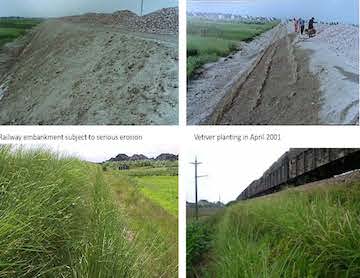 t Stabilization using Vetiver System. Liyu Xu, who started the China Vetiver Network in 1996, has produced a short description and images 14 years after the Xinchang railway Company planted 120,000 vetiver slips to stabilize a very difficult railway embankment using a sand fill. The vetiver was effective within 2 months of planting. The vetiver is still there and native plants have naturally colonized the embankment. Very poor farmers from the Dabie Mountains provided the original planting material, and since then farmers have cut the grass on the embankment for other uses, and have as a result pr t Stabilization using Vetiver System. Liyu Xu, who started the China Vetiver Network in 1996, has produced a short description and images 14 years after the Xinchang railway Company planted 120,000 vetiver slips to stabilize a very difficult railway embankment using a sand fill. The vetiver was effective within 2 months of planting. The vetiver is still there and native plants have naturally colonized the embankment. Very poor farmers from the Dabie Mountains provided the original planting material, and since then farmers have cut the grass on the embankment for other uses, and have as a result pr ovided the required "maintenance". China Railways has accepted the technology and promotes its use where appropriate. Everyone has benefited. What more does one need?!! See more on China Railways. ovided the required "maintenance". China Railways has accepted the technology and promotes its use where appropriate. Everyone has benefited. What more does one need?!! See more on China Railways.
Extreme Slope Stabilization using the Vetiver System by Paul Truong - Technical Director TVNI.
Published by Pacific Rim Vetiver Network. We Take this opportunity to thank and recognize the efforts of the Pacific Rim Vetiver Network and and the Office of the Royal Development Projects Board of Thailand for their wonderful and generous support in promoting the Vetiver System world wide both in research and technical publications. |
| SOIL NAILING |
On fragile slopes protecting high cost structures and subject to slippage engineered soil nailing backed by VS has proven a successful combination as shown in this presentation by Paul Truong |
| Vetiver System Technology for Infrastructure Stabilization |
A new presentation by Paul Truong with an excellent overview of VS capability for slope protection |
Application of VetiverSystem for Control of River Erosion |
Photo Essay By Shantanoo Bhattacharyya, Executive Engineer, PWD, Assam & Volunteer in Bioengineering
[email protected] |
Ho Chi Minh Highway (Vietnam) Fourteen Years Later
(2000- 2014) |
A Photo Essay on the Role of Vetiver System in Controlling Erosion on the Highway. .Following a Visit in February 2014
Dr. Paul Truong,TVNI Technical Director and Director for Asia and Oceania, Veticon Consulting, Brisbane , Australia
<[email protected]> |
GEOTROPISM IN VETIVER
(2013)
|
A photo essay of vetiver grass applied to various slope stabilization applications by Paul Truong, TVNI Technical Director.
THIS IS THE BEST COLLECTION OF VS SLOPE STABILIZATION EVER PUBLISHED AND EXPLAINS WHY VETIVER IS SO EFFECTIVE |
Integration of Vetiver System within conventional erosion control technologies in Brazzaville, Republic of the Congo: VARIOUS VIEWS OF CASIS GULLY |
A series of before and after images of the restoration of this massive gully. Courtesy of Alain Ndona - Vetiver Engineer |
Slope Stabilization in Itaipava‐Petropolis |
The vetiver solution was a total success after a landslide in 2008. This articile is particularly relevant now that the catastrophic landslides are back in full force in 2011. Read the pdf |
|
River and steep bank stabilization in Assam, India.
Two related files by Oliver Hawes and Shantanoo Bhattacharyya showing and discussing the work carried out by Shantanoo on some very big rivers in Assam, including the mighty Bramaputra. There were some failures, but mostly it was succesful and some very useful lessons can be learnt from this work. More at our blog site. |
Vetiver System for Erosion and Sediment Control, and Stabilisation of Steep Slopes |
Power Point by Paul Truong (pdf MB 2.6) With special reference to Vietnam |
Application of Vetiver Grass Technology in the Stabilisation of Road Infrastructure in the Wet Tropical Region of Australia
|
Power Point by Paul Truong |
Vetiver System for River Bank Stabilization
|
Power Point with special reference to river bank stabilization in Australia and Vietnam by Paul Truong. |
MOUNTAIN ROAD PROTECTION COLOMBIA (including Vetiver)
|
Meclas Ecologicas Parrael Control dela Erosion y La Estabilidad de Taludes English Spanish |
VETIVER GRASS SYSTEM FOR LANDSLIDE REHABILITATION WITH GEOFABRICS
|
Power Point by Paul Truong. |
VETIVER GRASS SYSTEM FOR LANDSLIDE REHABILITATION WITH HARD STRUCTURE
|
Power Point by Paul Truong.pdf |
Urban Ravine Stabilization in Brazzaville, Congo
|
This is a modified power point of Alain Ndona's work in stabilizing some massive urban ravines in Brazzaville. This follows his very succesful work in ravine stabilization in the DR Congo. |
PROTECCION DE TALUDES CON EL SISTEMA VETIVER FENOMENO HIDROTERMALISMO
CASO CENTRAL HIDROELECTRICA PLATANAR
SAN CARLOS, COSTA RICA
|
This review by Yorleny Cruz (in Spanish) looks at the use of VS for stabilizing earthworks and canal banks of hydro electric scheme in Costa Rica. The stabilization program was started 9 years ago, with succesful results. |
Wave Run-up Reduction through Vetiver Grass
|
This is an important MSc thesis by Auke Algera. It should be read in conjunction with Jasper Foch's thesis on the same topic. |
The Vetiver System for Infrastructure Stabilization in Africa
|
This is a modified power point showing how VS has been used for slope stabilization in Madagascar. It also shows how local communities have benefited from the production of vetiver plant material. The author, Roley Noffke, is a highly skilled and experienced road engineer and has worked widely with various Vetiver System applications. He can be contacted by email. |
|
This short series of images from Van Tran Tan of Vietnam gives a good idea how Vetiver System stabilized land slide prone slopes on the Ho Chi Minh Highway |
Vetiver - Soluciones Ambientales
en Biotecnología.
|
Vetiver - Soluciones Ambientales en Biotecnología. PowerPoint in Spanish by Yorleny Cruz Chaves,.
|

|
Vetiver Network Madagascar has produced its first newsletter. In the past Madagascar has demonstrated some excellent applications of VS. Now Yoann Coppin
of La Plantation Bemasoandro - VETIVER SYSTEM APPLICATIONS MADAGASCAR is developing a network and sharing information. Thanks Yoann for your initiative. Learn more ... |
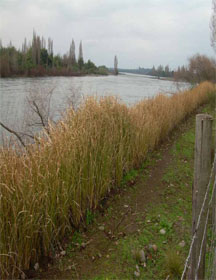
|
River bank stabilization in southern Chile. Germán Wallace of Pineda Bioingeniería Wallace y Cía, Ltd aConcepcion, Chile and Paul Truong
TVNI, Brisbane, Australia, have done some very interesting river bank stabilization in the cool temperate region of southern Chile. We hope to see an expansion of this type of VS application in Chile and elsewhere. Learn more about this initiative. |
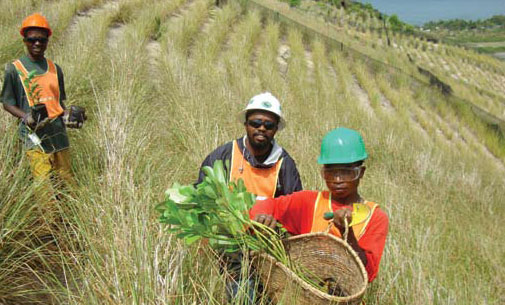
|
Fixing a major sand dune in Madagascar. Carol Knoll and Roley Nöffke's illustrated article in July/August 2008 issue of Environmental Management. Hydromulch (Pty) Ltd has been involved in a major sand fixing, erosion control and slope stabilisation undertaking along newly constructed roads at the Rio Tinto/QMM Ilmenite Project at Fort Dauphin in Madagascar. Wind blown sand was a major issue and a decision was made to use barrier netting and Vetiver Grass hedgerows |


 Biotechnology Environmental Solutions (Soluciones ambientales en biotecnología)using the Vetiver System. Yorleny Cruz , a TVNI Director and Coordinator for Costa Rica and Central America as well as a senior partner of Vetiver Panama SA, has shared with us an excellent
Biotechnology Environmental Solutions (Soluciones ambientales en biotecnología)using the Vetiver System. Yorleny Cruz , a TVNI Director and Coordinator for Costa Rica and Central America as well as a senior partner of Vetiver Panama SA, has shared with us an excellent 
 t Stabilization using Vetiver System. Liyu Xu, who started the China Vetiver Network in 1996, has
t Stabilization using Vetiver System. Liyu Xu, who started the China Vetiver Network in 1996, has  ovided the required "maintenance". China Railways has accepted the technology and promotes its use where appropriate. Everyone has benefited. What more does one need?!! See
ovided the required "maintenance". China Railways has accepted the technology and promotes its use where appropriate. Everyone has benefited. What more does one need?!! See 